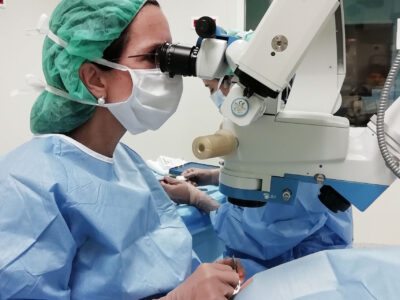
Advancements in Glaucoma Surgery: A Comprehensive Guide
Dec 10 2023 Glaucoma Surgery eye glaucoma glaucoma australia glaucoma natural treatment diet glaucoma symptoms and treatment glaucoma test for eyes glaucoma visual field symptoms of glaucomaGlaucoma is a group of eye diseases that can cause irreversible vision loss. It occurs when there is increased pressure in the eye, which damages the optic nerve over time. While glaucoma cannot be cured, advancements in surgical techniques have greatly improved the management of this condition. In this comprehensive guide, we will explore the various advancements in glaucoma surgery and how they have revolutionized the treatment options available for patients.
Understanding Glaucoma: A Brief Overview
Before delving into the advancements in glaucoma surgery and causes of glaucoma, it is important to have a basic understanding of the condition itself. Glaucoma occurs due to an imbalance in the production and drainage of fluid inside the eye. This buildup of fluid leads to increased intraocular pressure, damaging the optic nerve and causing vision loss. There are several types of glaucoma, including primary open-angle glaucoma, angle-closure glaucoma, and normal-tension glaucoma.
The Anatomy of the Eye and Glaucoma
To understand how glaucoma surgery works, it is essential to have a grasp of the anatomy of the eye. The eye is a complex organ comprising different structures, including the cornea, iris, lens, retina, and optic nerve. The cornea is the clear, dome-shaped front part of the eye that helps focus light onto the retina. The iris is the colored part of the eye that controls the amount of light entering the eye by adjusting the size of the pupil. The lens is a transparent structure that focuses light onto the retina. The retina is a thin layer of tissue at the back of the eye that contains millions of light-sensitive cells called photoreceptors. The optic nerve is responsible for transmitting visual information from the retina to the brain. In glaucoma, the optic nerve becomes damaged, leading to vision loss if left untreated.
Glaucoma can affect any part of the eye, but it most commonly affects the optic nerve. The optic nerve is like a cable that carries visual information from the eye to the brain. When the optic nerve is damaged, it can no longer transmit this information effectively, resulting in vision loss. The damage to the optic nerve is often caused by increased intraocular pressure, which occurs when the fluid inside the eye, called aqueous humor, cannot drain properly. This leads to a buildup of fluid and an increase in pressure, damaging the optic nerve over time.
See Also: Does weight loss eliminate sleep apnea?
Types of Glaucoma
Glaucoma can be classified into two main categories: open-angle glaucoma and angle-closure glaucoma. Open-angle glaucoma is the most common type and develops gradually over time. It is often referred to as “the sneak thief of sight” because it progresses slowly and without noticeable symptoms in its early stages. Angle-closure glaucoma, on the other hand, occurs rapidly and requires immediate medical attention to prevent irreversible vision loss. It is characterized by a sudden blockage of the drainage angle in the eye, leading to a rapid increase in intraocular pressure. This type of glaucoma can cause severe pain, blurred vision, and even nausea and vomiting.
Another type of glaucoma is normal-tension glaucoma, which is characterized by optic nerve damage and visual field loss despite having normal intraocular pressure. The exact cause of normal-tension glaucoma is still not fully understood, but it is believed to be related to poor blood flow to the optic nerve.
Symptoms and Risk Factors of Glaucoma
Glaucoma is often referred to as the “silent thief of sight” because it typically does not cause noticeable symptoms in its early stages. As the condition progresses, however, patients may experience a gradual loss of peripheral vision, difficulty adjusting to low lighting, and even complete blindness. Other symptoms may include blurred vision, halos around lights, and eye pain or redness.
While anyone can develop glaucoma, certain risk factors increase the likelihood of developing the condition. Age is a significant risk factor, with the risk of glaucoma increasing as a person gets older. Family history also plays a role, as individuals with a close relative with glaucoma are at a higher risk. Other risk factors include elevated intraocular pressure, certain medical conditions like diabetes and high blood pressure, and long-term use of corticosteroid medications.
It is important to note that glaucoma is a chronic condition that requires lifelong management. Early detection and treatment are crucial in preserving vision and preventing further damage to the optic nerve. Regular eye examinations, including measurements of intraocular pressure and evaluation of the optic nerve, are essential in diagnosing and monitoring glaucoma.
Traditional Glaucoma Surgery Techniques
Glaucoma is a complex eye condition that requires careful management to prevent vision loss. For many years, traditional glaucoma surgery techniques have been the gold standard in treating this condition. These procedures aim to create a new drainage channel for the intraocular fluid, reducing the pressure inside the eye and preventing further damage to the optic nerve.
One of the most widely performed glaucoma surgeries worldwide is trabeculectomy. This procedure involves creating a small hole in the sclera, the white part of the eye, to allow excess fluid to drain out. A thin, transparent “bleb” forms under the conjunctiva, the clear tissue that covers the eye, to collect the drained fluid. Trabeculectomy has proven to be highly effective in reducing intraocular pressure and preserving vision in patients with glaucoma.
However, trabeculectomy is not always the best option for every patient. In cases where this procedure is not feasible or has failed, glaucoma drainage devices may be utilized. These small implants, also known as “glaucoma tubes,” are placed inside the eye to facilitate the drainage of excess fluid. They consist of a tube or shunt that connects the anterior chamber, the front part of the eye, with a reservoir situated under the skin. Glaucoma drainage devices offer an alternative method for controlling intraocular pressure and managing glaucoma.
Another non-invasive glaucoma surgery technique is laser trabeculoplasty. This procedure utilizes laser energy to improve the drainage of fluid from the eye. Laser trabeculoplasty is typically recommended for patients with open-angle glaucoma who have not responded well to medication. During the procedure, the laser is used to target and stimulate the trabecular meshwork, which is the drainage system of the eye. This stimulation increases the efficiency of fluid outflow, helping to lower intraocular pressure.
It is important to note that while traditional glaucoma surgery techniques have been successful in managing the condition, they are not without risks. Like any surgical procedure, there is a potential for complications, such as infection, bleeding, or scarring. Additionally, these surgeries may require a significant recovery period and follow-up care to ensure optimal results.
Overall, traditional glaucoma surgery techniques, including trabeculectomy, glaucoma drainage devices, and laser trabeculoplasty, play a crucial role in the management of glaucoma. These procedures offer effective ways to reduce intraocular pressure and preserve vision in patients with this sight-threatening condition.
Recent Advancements in Glaucoma Surgery
In recent years, significant advancements have been made in glaucoma surgery, leading to the development of minimally invasive techniques and novel technologies that offer improved outcomes and faster recovery times for patients.
Minimally Invasive Glaucoma Surgery (MIGS)
Minimally invasive glaucoma surgery (MIGS) has emerged as a game-changing approach in the management of glaucoma. Unlike traditional glaucoma surgeries that involve creating large incisions, MIGS procedures are performed through tiny, self-sealing incisions. This significantly reduces the risk of complications and promotes quicker healing. MIGS techniques include the use of micro-stents, implants, and laser systems to enhance the natural drainage pathways of the eye.
One of the most exciting advancements in MIGS is the use of micro-stents. These tiny devices are inserted into the eye to create a new drainage pathway, allowing for better fluid outflow and reducing intraocular pressure. The XEN Gel Stent is a prime example of a minimally invasive implant that has shown promising results. It is made of a soft, gel-like material that is biocompatible and does not require sutures. The XEN Gel Stent is placed in the subconjunctival space, creating a passage for aqueous humor to flow out of the eye, effectively lowering intraocular pressure.
In addition to micro-stents, MIGS also utilizes implants that can enhance the natural drainage pathways of the eye. These implants are designed to be minimally invasive and can be inserted during cataract surgery or as standalone procedures. They provide a long-term solution for managing glaucoma by improving the outflow of fluid from the eye. Some commonly used implants include the iStent, Hydrus Microstent, and Kahook Dual Blade.
Advancements in Laser Surgery
Laser surgery for glaucoma has also seen advancements in recent years. Selective laser trabeculoplasty (SLT) is a type of laser surgery that targets specific cells in the trabecular meshwork, allowing for better fluid outflow. This procedure is repeatable and can be performed alongside medication or as a standalone treatment.
SLT works by using a low-energy laser to stimulate the body’s natural healing response, which leads to the remodeling of the trabecular meshwork. This remodeling improves the drainage of fluid from the eye, reducing intraocular pressure. SLT is a safe and effective treatment option for open-angle glaucoma and has shown promising results in reducing the need for medication in some patients.
Another significant advancement in laser surgery is laser-assisted cataract surgery (LACS). This technique combines the precision of laser technology with the removal of cataracts, allowing for the simultaneous treatment of both conditions. LACS offers several benefits for glaucoma patients, including improved accuracy in the placement of intraocular lenses and the ability to customize the procedure based on the patient’s specific needs.
Novel Glaucoma Drainage Devices
Innovative glaucoma drainage devices have been developed to address the limitations of traditional implants. These novel devices offer improved safety, efficacy, and patient comfort.
The CyPass Micro-Stent is one such device that has gained recognition in recent years. It is a small, flexible tube that is placed inside the eye to bypass the natural drainage system and facilitate fluid outflow. The CyPass Micro-Stent is designed to be minimally invasive and can be implanted during cataract surgery. It has shown promising results in reducing intraocular pressure and has been found to be safe and effective in clinical trials.
Another novel glaucoma drainage device is the InnFocus MicroShunt. This device is made of a biocompatible material and is implanted under the conjunctiva to create a new drainage pathway. The MicroShunt has shown positive outcomes in reducing intraocular pressure and has the potential to provide long-term control of glaucoma.
Overall, the recent advancements in glaucoma surgery have revolutionized the management of this sight-threatening condition. Minimally invasive techniques, such as MIGS and laser surgery, offer safer and more effective treatment options with faster recovery times. Additionally, novel glaucoma drainage devices provide alternative solutions for patients who may not be suitable candidates for traditional implants. These advancements have significantly improved the quality of life for glaucoma patients and continue to pave the way for further innovations in the field.
Comparing Traditional and Advanced Glaucoma Surgeries
When considering glaucoma surgery, it is important to weigh the pros and cons of traditional techniques versus the newer, advanced options available. Several factors come into play, including the efficacy and safety of the procedure, recovery time, patient comfort, and cost-effectiveness.
Efficacy and Safety
Traditional glaucoma surgery techniques, such as trabeculectomy, have established themselves as highly effective in reducing intraocular pressure and preserving vision. However, these procedures carry a higher risk of complications, such as infection and vision loss. In comparison, advanced glaucoma surgeries, such as MIGS, have demonstrated comparable efficacy to traditional techniques but with a significantly lower risk of adverse events.
Recovery Time and Patient Comfort
Recovery time and patient comfort are important considerations when choosing a glaucoma surgery. Traditional surgeries often require a longer recovery period, with more post-operative visits and the need for frequent eye drops. On the other hand, advanced glaucoma surgeries, especially MIGS procedures, typically involve less downtime, faster healing, and a reduced need for medications, resulting in a more comfortable experience for the patient.
Cost-effectiveness and Accessibility
Cost is another crucial aspect to consider. Traditional glaucoma surgeries can be expensive due to the complexity of the procedure and the need for extensive follow-up care. Advanced glaucoma surgeries, while initially costly, may offer long-term cost savings by reducing the dependency on medications and the frequency of clinic visits. Additionally, advanced techniques such as MIGS may be more accessible to a wider range of patients due to their minimally invasive nature.
In conclusion, advancements in glaucoma surgery have transformed the treatment landscape for patients with this sight-threatening condition. From traditional techniques to the emergence of minimally invasive procedures and novel technologies, there are now more options available than ever before. However, it is important to consult with an ophthalmologist to determine the most suitable surgical approach based on the specific type and severity of glaucoma, as well as individual patient factors. With ongoing research and technological advancements, the future of glaucoma surgery looks promising in improving outcomes and quality of life for patients worldwide.
Read More



